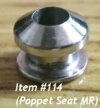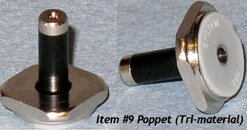It's not unusual at all that MARES 1sts show a 2 - 6 PSI higher IP at 600PSI tank pressure than at full tank. For an unbalanced 2nd this translates in a 0,1 - 0,2 lower cracking effort.
Surprising is only that a beginner can feel the difference.
I can only imagine that the regulator was adjusted pretty lousy (hard),so one could feel the difference. The OP mentioned that he got the air he needed, but that would be probably true also with a cracking effort of 2,6 inch/h2o.
Most 2nds which come from the factory, are adjusted at 1,4 - 1,5 inch/h2o, which is within the manufacturers specifications, but still far from what they can offer concerning the cracking effort.
I would not know what the change of the HP seat could have to do with the mentioned experience, I would guess they also readjusted the 2nds.



 .
.

